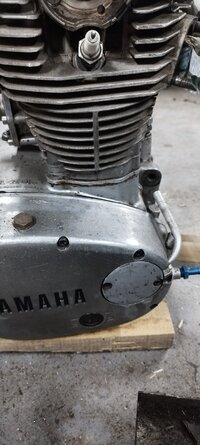Hey fishman, been chewing on your engine a bit more.
Did you have a closer look in the mean time?
There are some more costly options to get what you seem to have, using once 'commonly available' components.
Not impossible, as the sky was the limit in the XS's competitive sidecar cross days.
Possibly some previous owner preferred reliability over extreme engine displacement (not overboring the cylinder until there's almost no wall left).
In that case, you could have a long stroke (84mm) crankshaft combined with 80mm pistons (844cc).
Halfway the 70's, there was a factory kit with 80mm pistons, which would result in 750cc with a standard (74mm) stroke crankshaft.
Those pistons had 22mm pins, which would limit the choice of con rods to the 256 type.
The long stroke combination calls for a 4.5mm thick baseplate (+ gaskets) to achieve zero deck height.
In 750 form, this kit would already have a quite decent compression ratio; 10.9 at 0mm deck height, 9.3 at -1.5mm.
My first (very much abused by POs) XS, a daily rider XS2 bought around 1980, was set up like that.
It was quite temperamentful, and quickly taught me the right and wrong ways to kickstart, as well as putting carbs back into their rubbers along the side of the road. When we were still in the 'getting acquainted' phase, it used to kick back viciously and once made me go limp for several weeks.
If this is the combination you have, the compression ratio would be high, somewhere between 10.4 and 12.3.
Did you ever try to kickstart the engine? It would be quite a beast to kick over.
Do a compression test?
If you take off the bottom engine cover holding the oil suction filter, you can look at the position of the con rod big ends relative to the crankshaft wheels.
Compare them to (pics of) a standard crankshaft. If the big ends 'stick out' more, you have a stroker crankshaft.
Instead of the factory 80mm piston kit, someone could also have put in TX750 pistons, which have identical compression height etc.
Only, these are flat and have zero dome volume. Leading to very low compression ratio, like 6.9 to 7.5.
At least it would kick over easily!

